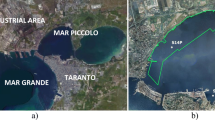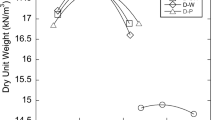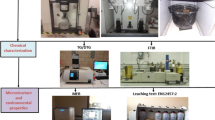Abstract
Purpose: Dredging of sediments, a requirement for harbor maintenance, removes millions of tons of mineral wastes, contaminated at varying degrees with trace metals, from the water. In previous investigations, Cu and Zn have been identified as highly concentrated trace metals associated to sulfides, mineral phases sensitive to oxidation. In order to ensure their sustainable management, the solidification/stabilization (S/S) and/or the valorization of contaminated sediments as secondary raw materials is a way to be promoted. Indeed, their reuse as a substitute of sand in cemented mortar formulation would allow combining both treatment and valorization of such wastes. Methods: In the present study, the environmental assessment of mortars formulated with raw and weathered marine sediments (in particular contaminated with Cu, Pb and Zn), compared to sand reference mortars, was conducted through two kinetic leaching tests: weathering cell tests (WCTs), in which mortars were crushed and leached twice a week, and a tank monolith leaching test (MLT), in which leaching was performed on monolithic mortars with increasing leachate renewal time. Results: In both leaching tests, calcium and sulfur were released continuously from sediment mortars, showing the oxidation-neutralization processes of sulfides and carbonates. In the MLT, Cu was released by sediment mortars through diffusion, particularly by weathered mortars, at low concentrations during 60 days of the test duration. With the more aggressive WCT, Cu concentrations were higher at the beginning but became negligible after 7 days of testing. Pb was released through diffusion mechanisms until depletion in both tests, whereas Zn was particularly well immobilized in the cemented matrices. Conclusions: The S/S process applied using hydraulic binders proved to be efficient in the stabilization of Cu, Pb, and Zn highly presents in studied sediments, and further valorization in civilian engineering applications could be considered.








Similar content being viewed by others
References
Agostini F, Skoczylas F, Lafhaj Z (2007) About a possible valorisation in cementitious materials of polluted sediments after treatment. Cem Concr Compos 29:270–278
AFNOR. (1986) Essais des eaux—dosage des ions sulfates—méthode néphélométrique. NF T 90–040
Akcil A, Erust C, Ozdemiroglu S, Fonti V, Beolchini F (2015) A review of approaches and techniques used in aquatic contaminated sediments: metal removal and stabilization by chemical and biotechnological processes. J Clean Prod 86:24–36
Aubertin M, Bernier L, Bussière B (2002) Environnement et gestion des rejets miniers [ressource électronique]: manuel sur cédérom: Mont-Royal. Presses internationales Polytechnique, Québec
ASTM. (2010) Standard test method for determination of pore volume and pore volume distribution of soil and rock by mercury intrusion porosimetry. ASTM D4404-10
Barna R, Sanchez F, Moszkowicz P, Méhu J (1997) Leaching behavior of pollutants in stabilized/solidified wastes. J Hazard Mater 52:287–310
Ben Allal L, Ammari M, Frar I, Azmani A, Clastres P, Jullien S (2011) Stabilization of contaminated canal sediments. Eur J Environ Civil Eng 15:293–302
Benzaazoua M, Bussière B, Dagenais A. Comparison of kinetic tests for sulfide mine tailings. Proceedings of tailings and mine waste ‘01, Balkema, Fort Collins 2001: 263–272
Benzaazoua M, Bussière B, Dagenais AM, Archambault M (2004a) Kinetic tests comparison and interpretation for prediction of the Joutel tailings acid generation potential. Environ Geol 46:1086–1101
Benzaazoua M, Fall M, Belem T (2004b) A contribution to understanding the hardening process of cemented pastefill. Miner Eng 17:141–152
Bisone S, Chatain V, Blanc D, Gautier M, Bayard R, Sanchez F, Gourdon R (2016) Geochemical characterization and modeling of arsenic behavior in a highly contaminated mining soil. Environ Earth Sci 75:306. doi:10.1007/s12665-015-5203-z, 1–9
Bouzahzah H, Benzaazoua M, Bussiere B, Plante B (2014) Prediction of acid mine drainage: importance of mineralogy and the test protocols for static and kinetic tests. Mine Water Environ 33:54–65
Bouzahzah H, Benzaazoua M, Mermillod-Blondin R, Pirard E. A novel procedure for polished section preparation for automated mineralogy avoiding internal particle settlement. 12th International Congress for Applied Mineralogy. Istanbul, Turkey, 2015
Bouzahzah H, Califice A, Benzaazoua M, Mermillod-Blondin R, Pirard E. Modal analysis of mineral blends using optical image analysis versus X ray diffraction. Proceedings of International Congress for Applied Mineralogy ICAM08. AusIMM, Brisbane, Australia, 2008
Caplat C, Texier H, Barillier D, Lelievre C (2005) Heavy metals mobility in harbour contaminated sediments: the case of Port-en-Bessin. Mar Pollut Bull 50:504–511
Cappuyns V, Deweirt V, Rousseau S (2015) Dredged sediments as a resource for brick production: Possibilities and barriers from a consumers’ perspective. Waste Manag 38:372–380
Casado-Martínez MC, Forja JM, DelValls TA (2009) A multivariate assessment of sediment contamination in dredged materials from Spanish ports. J Hazard Mater 163:1353–1359
Chatain V, Benzaazoua M, Loustau Cazalet M, Bouzahzah H, Delolme C, Gautier M et al (2013a) Mineralogical study and leaching behavior of a stabilized harbor sediment with hydraulic binder. Environ Sci Pollut Res 20:51–59. doi:10.1007/s11356-012-1141-4
Chatain V, Blanc D, Borschneck D, Delolme C (2013b) Determining the experimental leachability of copper, lead, and zinc in a harbor sediment and modeling. Environ Sci Pollut Res 20:66–74. doi:10.1007/s11356-012-1233-1
Chatain V, Sanchez F, Bayard R, Moszkowicz P, Gourdon R (2005) Effect of experimentally induced reducing conditions on the mobility of arsenic from a mining soil. J Hazard Mater 122:119–128
Chen Q, Tyrer M, Hills CD, Yang X, Carey P (2009) Immobilisation of heavy metal in cement-based solidification/stabilisation: a review. Waste Manag 29:390–403
Coussy S, Benzaazoua M, Blanc D, Moszkowicz P, Bussière B (2012) Assessment of arsenic immobilization in synthetically prepared cemented paste backfill specimens. J Environ Manag 93:10–21
Couvidat J. (2015) Gestion d’un sédiment de dragage marin contaminé : caractérisation de la réactivité biogéochimique, valorisation en mortier et évaluation environnementale. Université de Lyon. INSA de Lyon,
Couvidat J, Benzaazoua M, Chatain V, Zhang F, Bouzahzah H (2015) An innovative coupling between column leaching and oxygen consumption tests to assess behavior of contaminated marine dredged sediments. Environ Sci Pollut Res 22:10943–10955. doi:10.1007/s11356-015-4323-z
Couvidat J, Benzaazoua M, Chatain V, Bouamrane A, Bouzahzah H (2016) Feasibility of the reuse of total and processed contaminated marine sediments as fine aggregates in cemented mortars. Constr Build Mater 112:892–902. doi:10.1016/j.conbuildmat.2016.02.186
Cruz R, Méndez BA, Monroy M, González I (2001) Cyclic voltammetry applied to evaluate reactivity in sulfide mining residues. Appl Geochem 16:1631–1640
Dalton JL, Gardner KH, Seager TP, Weimer ML, Spear JC, Magee BJ (2004) Properties of Portland cement made from contaminated sediments. Resour Conserv Recycl 41:227–241
Durand C, Ruban V, Amblès A (2005) Characterisation of complex organic matter present in contaminated sediments from water retention ponds. J Anal Appl Pyrolysis 73:17–28
Fernández-Carrasco L, Torrens-Martín D, Morales LM, Martínez-Ramírez S. Infrared spectroscopy in the analysis of building and construction materials. INTECH Open Access Publisher 2012
French Official Journal. (2006) Arrêté du 09/08/06 relatif aux niveaux à prendre en compte lors d’une analyse de rejets dans les eaux de surface ou de sédiments marins, estuariens ou extraits de cours d’eau ou canaux publié au JORF n°222 du 24 septembre 2006 page 14082 texte n°15
Gadd GM (2004) Microbial influence on metal mobility and application for bioremediation. Geoderma 122:109–119
Gardner KH, Tsiatsios CJ, Melton J, Seager TP (2007) Leaching behavior of estuarine sediments and cement-stabilized sediments in upland management environments. Waste Manag 27:1648–1654
Hamer K, Karius V (2002) Brick production with dredged harbour sediments. An industrial-scale experiment. Waste Manag 22:521–530
Kundu S, Gupta A (2008) Immobilization and leaching characteristics of arsenic from cement and/or lime solidified/stabilized spent adsorbent containing arsenic. J Hazard Mater 153:434–443
Lafhaj Z, Samara M, Agostini F, Boucard L, Skoczylas F, Depelsenaire G (2008) Polluted river sediments from the North region of France: treatment with Novosol® process and valorization in clay bricks. Constr Build Mater 22:755–762
Le Guyader C. (2013) Enquête “Dragage 2010”—synthèse des données. In: CETMEF, editor. CETMEF, Margny Lès Compiègne, pp. 36
Li XD, Poon CS, Sun H, Lo IMC, Kirk DW (2001) Heavy metal speciation and leaching behaviors in cement based solidified/stabilized waste materials. J Hazard Mater 82:215–230
Limeira J, Agullo L, Etxeberria M (2010) Dredged marine sand in concrete: an experimental section of a harbor pavement. Constr Build Mater 24:863–870
Limeira J, Etxeberria M, Agulló L, Molina D (2011) Mechanical and durability properties of concrete made with dredged marine sand. Constr Build Mater 25:4165–4174
Lions J, Guérin V, Bataillard P, van der Lee J, Laboudigue A (2010) Metal availability in a highly contaminated, dredged-sediment disposal site: Field measurements and geochemical modeling. Environ Pollut 158:2857–2864
Lions J, van der Lee J, Guérin V, Bataillard P, Laboudigue A (2007) Zinc and cadmium mobility in a 5-year-old dredged sediment deposit: Experiments and modelling. J Soils Sediments 7:207–215
Malviya R, Chaudhary R (2006) Factors affecting hazardous waste solidification/stabilization: a review. J Hazard Mater 137:267–276
Mamindy-Pajany Y, Geret F, Roméo M, Hurel C, Marmier N (2012) Ex situ remediation of contaminated sediments using mineral additives: assessment of pollutant bioavailability with the Microtox solid phase test. Chemosphere 86:1112–1116
Mermillod-Blondin F, François-Carcaillet F, Rosenberg R (2005) Biodiversity of benthic invertebrates and organic matter processing in shallow marine sediments: an experimental study. J Exp Mar Biol Ecol 315:187–209
Mulligan CN, Yong RN, Gibbs BF (2001) An evaluation of technologies for the heavy metal remediation of dredged sediments. J Hazard Mater 85:145–163
OSPAR (2009) OSPAR guidelines for the management of dredged material. In: Commission O, editor. 2009/4
Othmani MA, Souissi F, Benzaazoua M, Bouzahzah H, Bussiere B, Mansouri A (2013) The geochemical behaviour of mine tailings from the Touiref Pb–Zn District in Tunisia in weathering cells leaching tests. Mine Water Environ 32:28–41
Paria S, Yuet PK (2006) Solidification–stabilization of organic and inorganic contaminants using portland cement: a literature review. Environ Rev 14:217–255
Peyronnard O, Benzaazoua M, Blanc D, Moszkowicz P (2009) Study of mineralogy and leaching behavior of stabilized/solidified sludge using differential acid neutralization analysis: part I: experimental study. Cem Concr Res 39:600–609
Rajasekaran G (2005) Sulphate attack and ettringite formation in the lime and cement stabilized marine clays. Ocean Eng 32:1133–1159
Raudsepp M, Pani E. (2003) Application of Rietveld analysis to environmental mineralogy. Mineralogical Association of Canada Short Course 31 (Chapter 8) 3: 165–180
Rekik B, Boutouil M (2009) Geotechnical properties of dredged marine sediments treated at high water/cement ratio. Geo-Mar Lett 29:171–179
Rozière E, Samara M, Loukili A, Damidot D (2015) Valorisation of sediments in self-consolidating concrete: mix-design and microstructure. Constr Build Mater 81:1–10. doi:10.1016/j.conbuildmat.2015.01.080
Samara M, Lafhaj Z, Chapiseau C (2009) Valorization of stabilized river sediments in fired clay bricks: factory scale experiment. J Hazard Mater 163:701–710
Sha W, O’Neill EA, Guo Z (1999) Differential scanning calorimetry study of ordinary Portland cement. Cem Concr Res 29:1487–1489
Shi C. (2004) Hydraulic cement systems for stabilization/solidification. Stabilization and solidification of hazardous, radioactive, and mixed wastes. Editado por RD Spence y C. Shi: 49–77
Van Hullebusch ED, Lens PN, Tabak HH (2005) Developments in bioremediation of soils and sediments polluted with metals and radionuclides. 3. Influence of chemical speciation and bioavailability on contaminants immobilization/mobilization bio-processes. Rev Environ Sci Bio/Technol 4:185–212
Villeneuve M, Bussière B, Benzaazoua M, Aubertin M. Assessment of interpretation methods for kinetic tests performed on tailings having a low acid generating potential. Proceedings of the 8th ICARD. Skelleftea, Sweden, 2009
Wang L, Tsang DCW, Poon C-S (2015) Green remediation and recycling of contaminated sediment by waste-incorporated stabilization/solidification. Chemosphere 122:257–264
WHO. (2011) Guidelines for drinking-water quality—4th edition. WHO chronicle. 38. World Health Organization, Geneva, Switzerland, pp. 541
Xu Y, Yan C, Xu B, Ruan X, Wei Z (2014) The use of urban river sediments as a primary raw material in the production of highly insulating brick. Ceram Int 40:8833–8840
Yan DYS, Tang IY, Lo IMC (2014) Development of controlled low-strength material derived from beneficial reuse of bottom ash and sediment for green construction. Constr Build Mater 64:201–207
Young RA. (1993) The Rietveld method. NYC, NY, USA: Oxford University Press
Zentar R, Wang D, Abriak NE, Benzerzour M, Chen W (2012) Utilization of siliceous–aluminous fly ash and cement for solidification of marine sediments. Constr Build Mater 35:856–863
Zoubeir L, Adeline S, Laurent CS, Yoann C, Truc HT, Benoît LG et al (2007) The use of the Novosol process for the treatment of polluted marine sediment. J Hazard Mater 148:606–612
Acknowledgments
The research presented in this paper was supported by the Region Rhône-Alpes with a CMIRA grant and by the University of Lyon-Saint-Étienne through financial travel support for the Ph.D. applicant. The authors are grateful to the Research and Service Unit in Mineral Technology (URSTM), University of Quebec in Abitibi-Temiscamingue (UQAT) for their experimental support. The authors also acknowledge the EEDEMS platform (French research network on waste and polluted materials management) for experimental support.
Author information
Authors and Affiliations
Corresponding author
Ethics declarations
Conflicts of interest
The authors declare that they have is no conflict of interests.
Additional information
Responsible editor: Philippe Garrigues
Rights and permissions
About this article
Cite this article
Couvidat, J., Benzaazoua, M., Chatain, V. et al. Environmental evaluation of dredged sediment submitted to a solidification stabilization process using hydraulic binders. Environ Sci Pollut Res 23, 17142–17157 (2016). https://doi.org/10.1007/s11356-016-6869-9
Received:
Accepted:
Published:
Issue Date:
DOI: https://doi.org/10.1007/s11356-016-6869-9




